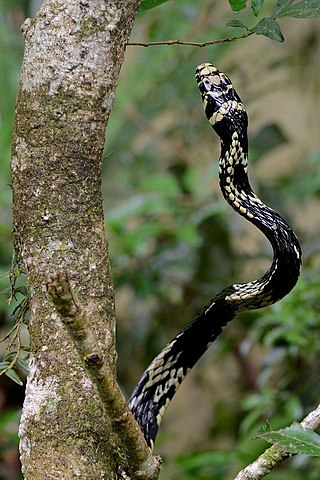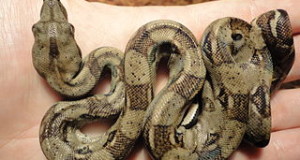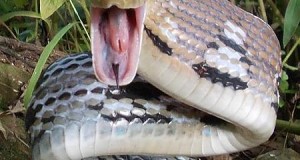The first time I saw an adult Tiger Ratsnake (Spilotes pullatus pullatus) streaking through the brush in Costa Rica, I was immediately struck by the appropriateness of its local name – the Thunder and Lightning Snake. Large, fast-moving, and eye-catching in coloration, this impressive beast stopped me in my tracks and made me gasp. I’d captured dozens of adult Green Anacondas and handled thousands of other snakes in zoos and the wild, but this Tiger Ratsnake was in a class by itself. Small wonder that it draws attention throughout its huge range, where it is known by many common names, including Tropical Ratsnake and Tropical Chicken Snake (the latter refers to its food preference on farms). The first individual I encountered eluded me, but I was eventually able to get my hands on other wild specimens, and to care for a few in captivity.
Description
Although not usually classified among the “giant serpents”, the Tiger Ratsnake is actually one of the longest snakes in the Americas. Adults average 6-7 feet in length, but may reach 10 feet; 14-foot-long individuals have been reported. They vary a good deal in color and pattern, but whether lemon-yellow with indigo-blue blotches or solid black speckled with orange, they are always stunning.
Natural History
The Tiger Ratsnake may be found from southern Mexico through Central America and across much of South America to northern Argentina. It also occupies Trinidad and Tobago. Five subspecies have been described. While it seems absent from the Amazon Basin, I wouldn’t be surprised if field surveys uncovered it there in the future.
Highly adaptable, the Tiger Ratsnake inhabits rainforest edges, open woodlands, brushy grasslands (please see habitat photo), thorn scrub and similar habitats. It readily colonizes farms, ranches and the outskirts of developed areas, where it is alternately welcomed as a rodent predator and persecuted for taking chickens and their eggs. Tiger Ratsnakes are equally at home on the ground or well-up in trees.
Tiger Ratsnakes are constrictors, and actively search out a wide variety of prey. Their appetites know no bounds – ground squirrels, rats and other rodents, possums, rabbits, bats, birds and their eggs, lizards, frogs, and other snakes are all consumed with equal gusto. Chickens and ducks (and cats, I’ll bet!) are taken near farms and villages.
Tiger Ratsnakes as Pets
It’s difficult for most snake enthusiasts to resist this huge, spectacularly-colored serpent, and the few that appear for sale are always quickly snatched-up (at premium prices!). However, it’s important to understand that Tiger Ratsnakes require more space and upkeep than similarly-sized species…think in terms of an adult Indigo Snake or Cribo. They have fast metabolisms, and their waste products are copious.
The Terrarium
Tropical Ratsnakes are quite active and require considerably more room than do typical North American ratsnakes (they are not close relatives, but the terminology is established in the pet trade). Adults do best in custom-built cages measuring at least 6 x 5 feet. Stout climbing branches will be well-used.
A hide box should always be available, but many individuals prefer a forked tree branch screened by hanging plants (this model, which features suction cups, works well) to typical caves; even long-term pets may be stressed if forced to remain in the open.
Substrate
Cypress mulch, eucalyptus bark and similar materials may be used as substrates; due to this snake’s vigorous movements, newspaper tends to wind up crumpled in a corner. Washable terrarium liners may be used for younger animals kept in aquariums.
Heat and Light
Tiger Ratsnakes fare well in a temperature range of 78-86 F; night-time temperatures can be allowed to drop to 75 F or so. A spotlight-type bulb should be used to create a basking spot of 90 F.
Large enclosures are necessary if a thermal gradient (areas of different temperatures) is to be established. Thermal gradients, critical to good health, allow snakes to regulate their body temperature by moving from hot to cooler areas.
A ceramic heater, heat pad, or red/black reptile night bulb can be used to provide heat after dark.
Feeding
As mentioned above, Tiger Ratsnakes accept a huge array of prey items. Captives do fine on a straight mouse and rat diet. Unlike some snakes, they tend not to become “fixated” on certain foods, so you can offer variety in the form of chicks, gerbils and other creatures without fear of causing a problem (I had a Green Anaconda that accepted only muskrats, another that “insisted” on wild-caught Norway rats!). Hungry individuals strike wildly, so exercise care at feeding time.
Water for drinking and soaking must always be available. Bowls should be filled to a point where they will not overflow when the snake curls up within, as damp conditions will lead to fungal infections of the skin and other health problems.
Breeding
Captive breeding is fairly regular, but it would be great to see more interest in this spectacular snake. Pairs must be monitored carefully, as aggression may occur. However, unlike many similar species, compatible pairs can usually be housed together year-round. A clutches generally contain 8-15 eggs, which may be incubated in moist vermiculite (1:1 ratio of water to substrate by weight) at 80 F for 70-80 days.
Handling
Wild-caught individuals must be approached with caution. Many calm down in time, but even long-term pets tend to move about when held, and can be difficult to control. Care must be exercised, as they seem always on the lookout for food, may strike at nearby movements.
 That Reptile Blog – Reptile, Amphibian and Exotic Pet Care and Information
That Reptile Blog – Reptile, Amphibian and Exotic Pet Care and Information







Dear Mr Indiviglio,
That was a very nice article on the Tiger Ratsnake. I always like when some natural history is presented to better understand captive care.
Kindest regards,
Walter
Thanks, Walter; Ialways try to do that, glad you noticed and enjoyed, best, Frank
Hi what is the temperature day time and night time for breeding session please?
And when it start the breeding?
also how many hourse day light should be ?
I have a pair and I would like to breed them.
Thanks
Hello,
They have a long breeding season..captives have bred between Jan and June. No need to manipulate temperatures, can keep as described in article. A q2-14 hour daytime period can be maintained year-round/. key to breeding seems lie in the snakes settling in, feeling comfortable…unlike most, keeping pair together year-round is preferable to splitting. Large cage with several hide sites, climbing space best. Good luck, please keep me posted, Frank
This was really helpful, thanks for sharing the info. I just purchased a tiger rats make the other day and your definitely right about them striking wildly. Mine hit his mouse so hard he smacked it into the glass knocking it unconscious. I will be looking for a female in the near future after finishing a custom cage similar to what you described. I’ve built one for my other pair of snakes “amazon tree boas” definitely want to breed them. I’ve observed the boas mating twice so hopefully I’ll have some success with both species in the future.
Hello Charles,
Glad you enjoyed, thanks for the feedback.
Best to provide dead rodents only…the snake will be bitten in time, and the resultant infections are often serious.
Best regards, Frank
I’ve recently gotten into the habit of knocking out mice before I fed them to my snakes for the reason you just mentioned. I tried that first with the tiger and he ignored it. Hopefully he will come around just like my tree boas did eventually. In the meantime I never leave them unattended and if the mouse isn’t eaten immediately I remove it after about 5 min. I’ve seen some horrific injuries from rodent bites and infections. The dealer I bought him from uses small rats but I went with the mice because their smaller and just fed him 2 smaller ones. Anyway thanks for the warning. I noticed you worked at the Bronx zoo which is the first place I ever saw one of these snakes when I was a little kid. Their color and size fascinated me and now the attitude as well haha. Take care
Hi Charles,
Many firsts for me at the Bx Zoo as well (I grew up nearby)…
None will refuse dead prey long term…moving via tongs may help, but they all take them eventually. Enjoy, Frank
I have no intention to give up, my tree boas were a big pain at first but using forceps helped bring them around, besides their teeth are too long for me to let my fingers anywhere near them when they are hungry haha. I’m sure my tiger rat will settle down too. I will say that the boas show a huge preference for fresh rather than frozen often even regurgitating previously frozen mice. I don’t know if they can sense heartbeat, but their reaction seems to suggest something like this. Knocking mice out is unpleasant but my snakes seem to appreciate it.
Hi Charles,
I hope all goes well, enjoy and please keep me posted, Frank
Fed the tiger rat snake Saturday evening and he ate 1 dead mouse finally. I remembered a trick my dad used and just sealed it in a jar. Immediately after it stopped moving I gave it to the snake and he hesitated at first but he did come around and eat it. Next week I will try for all of them. I want to get a couple chicks and see what happens since as you said they are known for eating farmers chickens. Cheaper than mice in my neighborhood probably alternate so he can get a more varied diet. Anyway figured I’d give you an update.
Thanks, Charles,
I don’t have any experience raising them solely on chicks, should be fine…some individuals become fixated on them and refuse rodents for awhile (but, as with most, hunger works wonders…my grandmother used it on me, and now I eat everything!). Cleanup after chick meals can be a bit messier than with mice. Enjoy, Frank
Yeah I won’t be using chicks often. More like an occasional treat. We’ll see what happens.
The snake is getting ready to shed so the chicks or mice are on hold for now. But he’s doing awesome and ate one fresh killed mouse last feeding. I think he will be eating thawed or killed exclusively soon. A lot easier and safer like you said. Got reminded the other day how strong a mouses bite can be the other day before I fed my tree boas. Little bugger punched a hole in my thumb hahaha. Guess I asked for it but not fun at all haha
Hi Charles,
Good to hear. Re the mouse bite…seems like a small thing, I know, and snake keepers tend to shrug them off, but I suggest a call to your doctor, for advice…tetanus shot may be advisable (has no connection to size of wound, etc) and mice host an array of other nasty micro-orgs in their mouths, best, Frank
Thanks for the concern Frank. While I didn’t go to the Dr, I’m always current on my shots and cleaned the bite immediately. I never allow my shots to lapse after catching typhoid fever in 2008 not long after my wedding haha. I used it as an example for my soldiers when I was still serving. Everything healed up just fine but on the next occasion I might err on the side of caution and wear gloves haha it hurt worse than most of the snake species I’ve kept.
Good to hear…nothing like rodent teeth! I was often around capybaras when in Venezuela…roundups are still done via horse during hunts on the ranches..bites to lowered legs of horses are said to cause fatalities. When I worked with rodents at the Bx Zoo, I found female Cloud and Pouched rats defending young as unapproachable as leopards!
I do the same with younger biologists who have been with me on field work; malaria killed a co-worker in India, who was likely not as careful as he should have been.
Enjoy, best, frank
Sorry to hear about your coworker. Malaria is a really scary illness I’ve traveled in places where it is relatively common and I am very careful to use repellent and long sleeves etc. Interesting you should mention being careful as that is most likely what happened to me, probably didn’t wash my hands or something after hiking around and had a drink of water or ate something. I was the only one out of all of us that got sick. Interesting and a little scary about the capybara haha doesn’t surprise me that they can cause serious injury although I am surprised they’ve cause fatalities in the horses. In the Philippines I’ve seen Norway rats with a litter of pups back down dogs before, pretty impressive stuff.
Thanks…as entomologist E O Wilson has said (more or less)…It’s the little things that run the world. Best, frank
Been quite awhile since I posted Frank but you will be happy to know my tiger rat came around and is eating his mice dead now. I haven’t used frozen ones yet but euthanizing them in a closed jar worked perfectly and he didn’t hesitate more than a couple prods with the mouse in tongs. He just shed again yesterday so I will be picking up some frozen mice today or tomorrow. And we’ll see I doubt its going to be a problem anymore. Anyway take care and thanks again for the info and conversation.
My pleasure, Charles, thanks for the update…enjoy and please keep me posted, frank
BTW I know they are large and long snakes but didn’t realize how quickly they grow. Only been about 2 months since his last shed haha definitely cool snakes. This time the skin came off in nearly a single piece. I just upped the spraying to raise the humidity. The first shed was stuck in several places but this one was nearly perfect. Going to be used by my friends daughter for science class haha. I think she is expecting a small skin. This one is twisted up and still just about 6 feet
Hi Charles…yes, they seem to have very fast metabolisms; great that you are helping children to learn about snakes, I do the same…enjoy, Frank
I have been keeping this species and breeding them for years and never once have I witnessed one constricting prey- mine always thrash prey about until it’s swallowed, much like Indigos. Otherwise, good work on this article!
Thanks, Will.
Yes, very much like indigos in that regard..field reports also indicate that small prey items are swallowed alive, larger sometimes pressed against substrate rather than constricted. Best, Frank